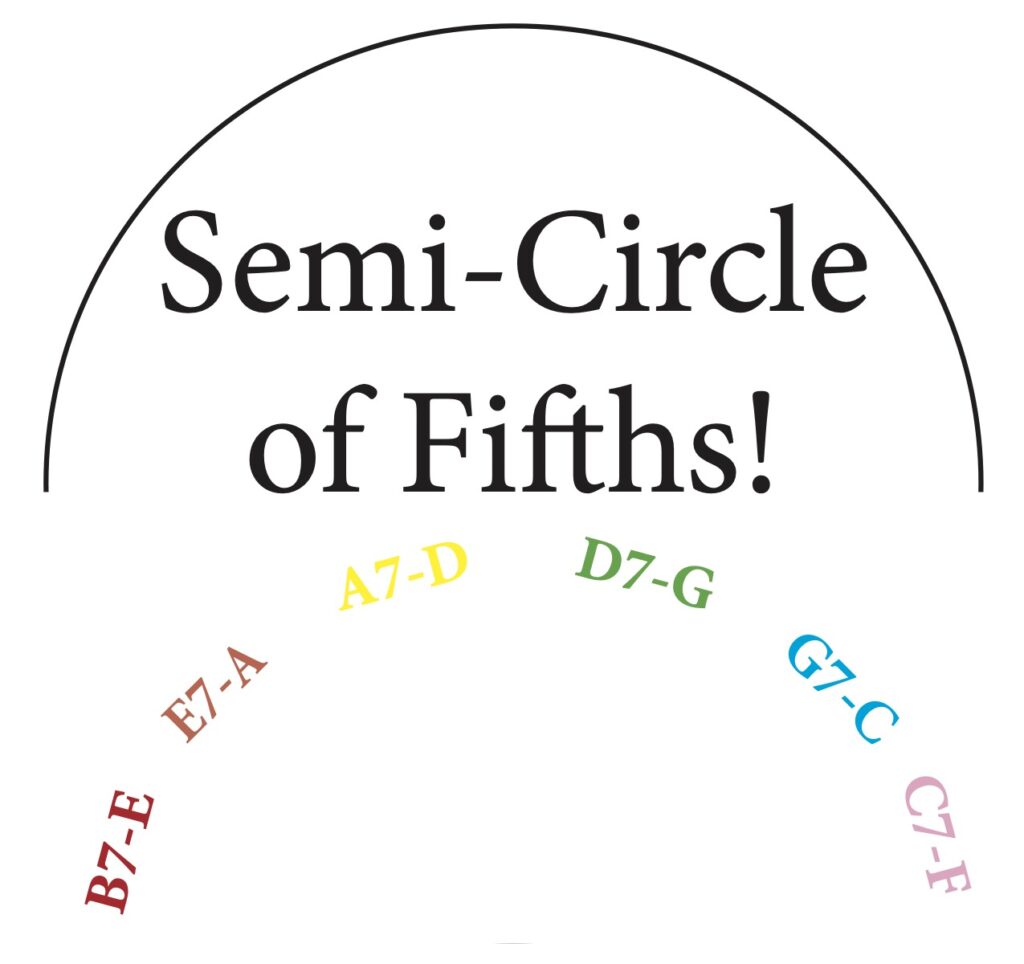In the acoustic guitar world — outside of jazz and strict classical — we seldom use certain parts of the “Circle of Fifths.” We prefer to stick to the half of the Circle that uses open strings. Hence my “Semi-Circle of Fifths” term. I’ll explain.
In a few words, the Circle of Fifths is Western harmony’s “tension-resolution” idea (V7-I — G7-C) carried to the extreme. Likely you’ve played E7 to A (V7-I) ), A7 to D (V7-I), D7 to G and G7 to C, in that order. That is one-third of the Circle of Fifths. If you keep going — making each I chord into a V7 (C into a C7, for instance) — you’ll come all the way back around to where you started, touching all 12 notes of our Western chromatic scale. Hence the name “Circle” of Fifths. NOTE: I’ve NEVER seen a piece of music that goes all the way around. Perhaps there is one. Let me know!
Using the sequence listed in the previous paragraph (E7 all the way to C ), there are only two more V7-I chord changes that guitarists regularly use: B7 to E and C7 to F. Attach these two on the ends of the list above and you have 1/2 of the Circle of Fifths — my “Semi-Circle of Fifths.” (See the cute graphic.)

Non-classical guitarists seldom use the other half of the Circle of Fifths:
F7 to B-flat,
B-flat7 to E-flat,
E;flat7 to A-flat,
A-flat7 to D-flat and
C#7 (D-flat7) to F# (G-flat).
The main reason: The six V7 chords listed in paragraphs 2 & 3 and in the graphic are familiar, relatively easy fingerings on the guitar — (almost) ALL of which can be played using open strings. The others require all fretted strings (nearly) and don’t take advantage of the tone and ease of open-string use.
The Circle of Fifths features this “dominant-to-tonic” chord progression — also known as V-I or V7-I. The “V7” chord, built on the fifth note of a scale (hence the “V” designation: the “dominant”), contains the “tri-tone” interval (1/2 an octave) which uses two frequencies that do not mesh well, We (have been conditioned to) perceive this interval as ‘dissonant.’ By adding part of the Circle of Fifths to a chord progression you produce a rising expectation amongst the listeners that you are driving the music to a new chord/key, This is very common in ragtime: a D7 preceding the G/G7 heading back to the key of C — often at the end of the bridge section.
Copyright © 2023 Accent On Music, LLC & Mark D. Hanson. All Rights Reserved.


One thought on ““Semi-Circle” of Fifths!”
Hi Mark,
Very interesting idea for the “semi-circle of fifths”! Kudos for thinking of it….
You mentioned pieces of music which cycle through all of the positions on the cycle, all twelve keys. I am not aware of any composed pieces which do so – and there may be some! – but jazz musicians have long-employed the cycle as a means of enlivening live performances and also in jam sessions and “cutting contests.” Such as playing “Cherokee” at a breakneck tempo through all twelve keys. Separates the pros from the also-rans pretty quickly. In my brief sojourn as a jazz cat, thank goodness I was never called upon to try that – but in the old days, it was fairly common.